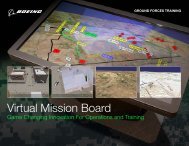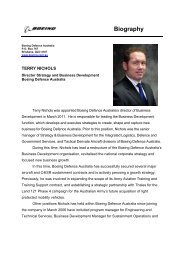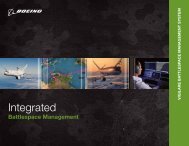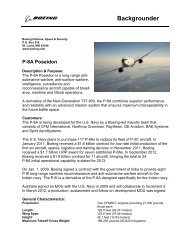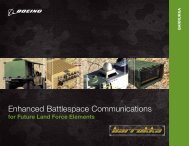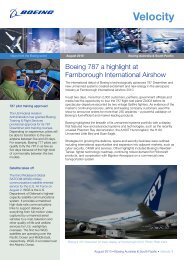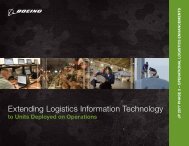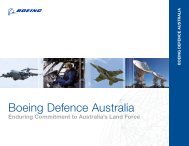Wedgetail Airborne Early Warning & Control - Boeing Australia
Wedgetail Airborne Early Warning & Control - Boeing Australia
Wedgetail Airborne Early Warning & Control - Boeing Australia
You also want an ePaper? Increase the reach of your titles
YUMPU automatically turns print PDFs into web optimized ePapers that Google loves.
Backgrounder<br />
<strong>Boeing</strong> Defense Space & Security<br />
P.O. Box 516<br />
St. Louis, MO 63166<br />
www.boeing.com<br />
737 <strong>Airborne</strong> <strong>Early</strong> <strong>Warning</strong> and <strong>Control</strong><br />
Description and Purpose:<br />
737 <strong>Airborne</strong> <strong>Early</strong> <strong>Warning</strong> and <strong>Control</strong> (AEW&C) is a<br />
state-of-the-art system providing powerful airborne<br />
surveillance, communications and battle management.<br />
Customers:<br />
The <strong>Australia</strong>n Defence Force selected the 737 AEW&C system in July 1999. A contract<br />
for Project <strong>Wedgetail</strong> was signed in December 2000 for four 737–700 aircraft and six<br />
AEW&C systems plus options for three additional systems. In 2004, <strong>Australia</strong> exercised<br />
options to purchase two additional 737-700 aircraft. Two of the aircraft were modified into<br />
the AEW&C configuration at a <strong>Boeing</strong> facility in Seattle. The other four were modified by<br />
<strong>Boeing</strong> Defence <strong>Australia</strong> in a company facility at Royal <strong>Australia</strong>n Air Force (RAAF)<br />
base Amberley.<br />
<strong>Boeing</strong> delivered the two aircraft in November 2009 and has been supporting RAAF<br />
training on the AEW&C system, which includes the aircraft as well as the Operational<br />
Flight Trainer, Operational Mission Simulator and Mission Support System.<br />
In May 2010, the aircraft were initially accepted by the Commonwealth of <strong>Australia</strong> into<br />
the RAAF fleet. This major milestone demonstrated that the 737 AEW&C system was<br />
ready for operational training and use. It also represented the culmination of years of<br />
design, development, modification and testing by the <strong>Boeing</strong>-led team.<br />
Since then, four more <strong>Wedgetail</strong> aircraft have been delivered and being operated by the<br />
RAAF. In Nov. 2012, the program reached a major milestone when the RAAF declared<br />
Initial Operating Capability (IOC) for the fleet. IOC means the <strong>Wedgetail</strong> aircraft is ready<br />
to be operationally deployed anywhere in the world and takes into account not only the<br />
aircraft, but also logistics and sustainment, training of air crews, ground crews and<br />
technical support staff. In Dec. 2012, the Commonwealth completed its acquisition of th<br />
six AEW&C aircraft and related mission systems by accepting the final design of the<br />
<strong>Wedgetail</strong> airborne mission segment.<br />
In November 2000, the Republic of Turkey selected a <strong>Boeing</strong>-led team to begin contract<br />
negotiations on developing a new AEW&C system. A contract was signed in June 2002<br />
and officially started in July 2003. The program, known as Peace Eagle, includes four<br />
737 AEW&C aircraft plus ground support segments for mission crew training, mission<br />
support and system maintenance support. Verification testing of the system began in
2011 in labs and on the aircraft on the ground and in flight and is proceeding as planned.<br />
Verification testing will continue in Puget Sound, and Turkey. Meantime, preliminary<br />
mission system testing for Peace Eagle #2 is underway. Delivery of the first Peace Eagle<br />
aircraft is scheduled for early 2013.<br />
<strong>Boeing</strong> signed a contract in November 2006 to provide four 737 AEW&C aircraft for the<br />
Republic of Korea’s EX program, known as Peace Eye. The <strong>Boeing</strong> team’s solution also<br />
includes ground support segments for flight and mission crew training, mission support<br />
and aircraft and system modification support. Peace Eye aircraft #1 was delivered to the<br />
Republic of Korea Air Force in September 2011 followed by delivery of the second<br />
aircraft in Dec. The third Peace Eye aircraft was delivered to the ROKAF in May 2012.<br />
The fourth and final aircraft in the fleet was delivered in Oct. 2012.<br />
737 AEW&C gives Korea a powerful capability for airborne surveillance, communications<br />
and battle management. It also provides increased security for the Korean peninsula<br />
against today’s threats and threats in the future.<br />
General Characteristics:<br />
737-700 increased gross weight (IGW) airframe<br />
Northrop Grumman “MESA” electronically scanned array radar system<br />
360 degrees/Air and Maritime modes/200 + nmi range/All Weather<br />
IFF: 300 nmi<br />
Open system architecture/COTS<br />
6 to 10 multi-role/purpose consoles<br />
Precision Tracker<br />
Communications include, but are not limited to, (3) HF, (4) VHF/UHF, (4) UHF and Link 11 &<br />
16 (Customer selects encryption capability) (2) Have Quick<br />
Operational ceiling: 41,000 ft<br />
Range: 3,500 nm<br />
Flight Crew: 2<br />
Mission Crew: 6 to 10<br />
Miscellaneous:<br />
The platform is the <strong>Boeing</strong> Next-Generation 737-700 featuring 21st century avionics,<br />
navigation equipment and flight deck. Because of its high technology, the aircraft<br />
requires minimal downtime for maintenance.<br />
The 737 series is one of the most popular and reliable jet aircraft in the world. Its<br />
popularity has resulted in a worldwide base of suppliers, parts and support equipment.<br />
The Multi-role Electronically Scanned Array (MESA) radar is the critical sensor aboard<br />
the 737 AEW&C. The steerable beam, L-band electronically scanned array is designed<br />
to provide optimal performance in range, tracking, and accuracy. The radar is able to<br />
track airborne and maritime targets simultaneously and can help the mission crew direct<br />
the control of fighter aircraft while continuously scanning the operational area.
The so-called ’top hat’ portion of the MESA radar provides a practical solution for fore<br />
and aft coverage while maintaining the low drag profile of the dorsal array system. This<br />
allows the system to be installed on the mid-size 737-700 platform without significant<br />
impact on aircraft performance. Another innovation is the integrated Identification Friend<br />
or Foe sharing of the primary radar arrays to further reduce weight, improve reliability,<br />
and simplify target correlation. In addition, the 737 AEW&C has an advanced open<br />
system architecture with a standards-based design for cost-effective commonality and<br />
maximum flexibility.<br />
###<br />
Contact:<br />
Dave Sloan<br />
Communications<br />
(253) 657-8008<br />
david.a.sloan@boeing.com<br />
November 2012





